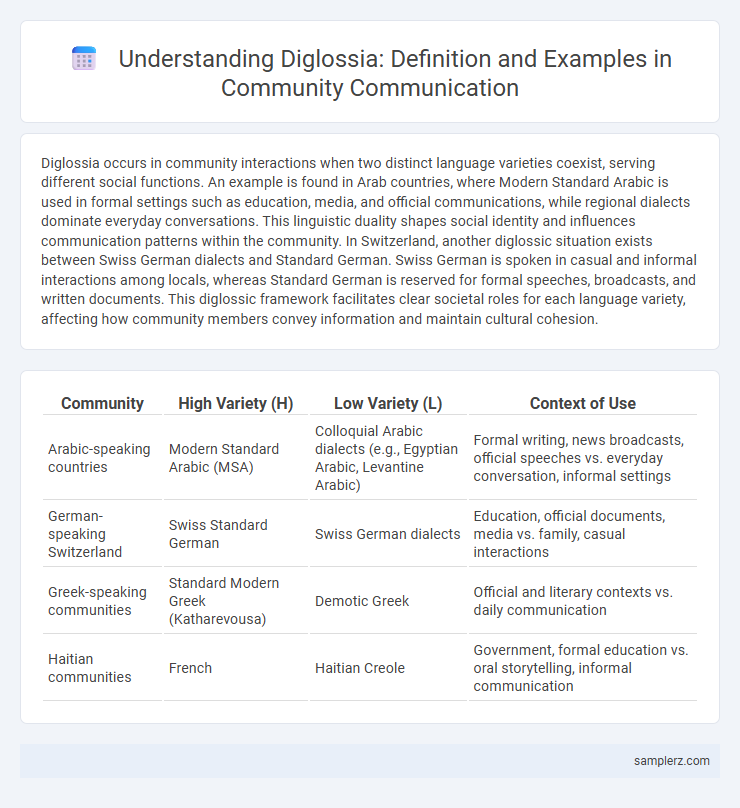Diglossia occurs in community interactions when two distinct language varieties coexist, serving different social functions. An example is found in Arab countries, where Modern Standard Arabic is used in formal settings such as education, media, and official communications, while regional dialects dominate everyday conversations. This linguistic duality shapes social identity and influences communication patterns within the community. In Switzerland, another diglossic situation exists between Swiss German dialects and Standard German. Swiss German is spoken in casual and informal interactions among locals, whereas Standard German is reserved for formal speeches, broadcasts, and written documents. This diglossic framework facilitates clear societal roles for each language variety, affecting how community members convey information and maintain cultural cohesion.
Table of Comparison
| Community | High Variety (H) | Low Variety (L) | Context of Use |
|---|---|---|---|
| Arabic-speaking countries | Modern Standard Arabic (MSA) | Colloquial Arabic dialects (e.g., Egyptian Arabic, Levantine Arabic) | Formal writing, news broadcasts, official speeches vs. everyday conversation, informal settings |
| German-speaking Switzerland | Swiss Standard German | Swiss German dialects | Education, official documents, media vs. family, casual interactions |
| Greek-speaking communities | Standard Modern Greek (Katharevousa) | Demotic Greek | Official and literary contexts vs. daily communication |
| Haitian communities | French | Haitian Creole | Government, formal education vs. oral storytelling, informal communication |
Understanding Diglossia: A Brief Overview
Diglossia occurs in community interaction when two distinct language varieties coexist, such as Classical Arabic for formal communication and Modern Standard Arabic for everyday use. This linguistic phenomenon highlights how speakers switch between high (H) and low (L) language varieties depending on social context, reinforcing cultural identity and social hierarchy. Understanding diglossia reveals its impact on effective communication, language preservation, and educational strategies within multilingual communities.
Classic Examples of Diglossia in Global Communities
In many Arabic-speaking countries, diglossia is evident as speakers alternate between Modern Standard Arabic for formal communication and regional dialects in casual interactions. Switzerland presents another classic example, where residents use Swiss German dialects in daily conversation and High German for official and written contexts. These linguistic dynamics shape community interaction by maintaining distinct language varieties for varying social functions and domains.
Diglossia in Daily Social Interactions
Diglossia in daily social interactions often appears in bilingual communities where speakers switch between a high (formal) language for official or public communication and a low (informal) language for casual conversations. For instance, in Arabic-speaking communities, Modern Standard Arabic is used in education and media, while regional dialects dominate home and marketplace interactions. This linguistic division shapes social dynamics, reinforcing cultural identity and functional language use within the community.
Diglossic Language Use in Educational Settings
In educational settings, diglossic language use often manifests through the distinction between the formal language of instruction and the colloquial dialect spoken by students in their communities. For example, Arabic-speaking students may use Modern Standard Arabic during lessons while relying on regional Arabic dialects for informal interactions outside the classroom. This diglossic dynamic shapes communication patterns, influencing language development and social identity within the educational environment.
Media and Diglossic Communication Patterns
In media, diglossic communication patterns reveal how communities use high and low language varieties to address diverse audiences, with formal broadcasts typically employing the standard language and informal social media interactions favoring vernacular speech. This dynamic facilitates effective information dissemination while preserving cultural identity and linguistic heritage within the community. Studies highlight that such media practices enhance public engagement by accommodating diglossic speakers' varying linguistic competencies.
Religious Practices and Diglossic Speech
In religious practices, diglossic speech often manifests as the use of a sacred or classical language, such as Classical Arabic in Islamic prayers, alongside the community's everyday vernacular. This linguistic duality allows congregants to engage in both formal worship and informal interactions, preserving spiritual traditions while maintaining clear communication in daily life. The coexistence of these language varieties reinforces identity and facilitates community cohesion in diverse religious settings.
Workplace Communication: High vs. Low Varieties
In workplace communication, diglossia manifests through the use of high and low language varieties, where formal jargon and technical terms dominate official meetings and documents, while informal, colloquial language is prevalent in casual office interactions. This linguistic duality enhances clarity and precision during professional exchanges yet fosters camaraderie and ease in everyday conversations. Understanding this stratification improves employee interaction and reduces communication barriers in multicultural corporate environments.
Diglossia and Generational Language Shifts
Diglossia in community interaction often manifests through distinct language use between generations, where older members typically maintain a classical or formal language variety while younger members adopt a more colloquial or hybrid form. This generational language shift reflects social dynamics and identity, as younger speakers may prefer vernacular dialects or blended languages influenced by media and globalization. Studies in Arabic-speaking communities highlight this phenomenon, with Modern Standard Arabic reserved for formal contexts and regional dialects dominant in everyday communication among youth.
Challenges Posed by Diglossic Environments
Diglossic environments in community interaction present significant challenges, such as reduced effective communication due to the coexistence of a high (formal) and low (informal) language variant. This linguistic division often leads to misunderstandings, social stratification, and limited access to education and public services, as speakers may struggle to switch between language forms appropriately. Moreover, diglossia can hinder social cohesion by reinforcing barriers between different social groups within the community.
Preserving Cultural Identity through Diglossic Practices
Diglossia in community interaction often manifests through the use of a high, formal language for education and official communication alongside a vernacular dialect for daily conversations, reinforcing cultural identity. This linguistic duality allows communities to preserve traditional expressions and oral heritage while engaging with broader societal institutions. Maintaining diglossic practices strengthens cultural cohesion and fosters intergenerational transmission of local values.

example of diglossia in community interaction Infographic
 samplerz.com
samplerz.com